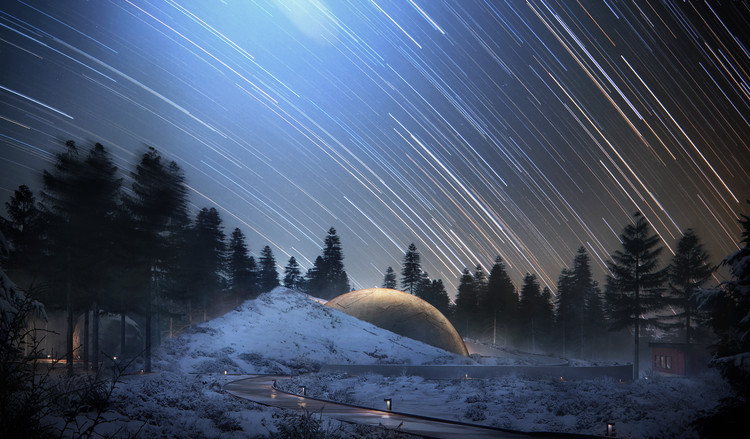
Snøhetta have released images of their proposed planetarium and visitor’s center for Norway’s largest astronomical facility. Nestled in a dense forest 28 miles (45 kilometers) north of Oslo, the scheme features a new 16,000 square foot (1,500 square meter) planetarium, and “interstellar cabins” mimicking small planets.
The facilities seek to offer a range of scientific activities to be experienced by the public, including astronomy, sun studies, and natural science, permitting the exploration of the night sky, and the Northern Lights.


Located at the “Solobservatoriet” observatory, one of Northern Europe’s foremost astronomical research stations, the scheme sits alongside an original solar observatory built in 1954. Throughout the design process, the architects engaged with simple principles of astronomy, with cabins situated around the planetarium inspired by the orbit of planets around the sun. The facilities are designed to accommodate up to 120 guests, engaging visitors with an “intellectual, visual, tactile journey into the realm of astronomy.”

Fulfilling the Institute’s mission to enlighten the public about the wonders of the universe, the new Snøhetta designed astronomical facility is designed to inspire a sense of wonder and curiosity as if the architecture itself was asking the question: Where does the Universe come from?
-Snøhetta Press Release

The Planetarium dominates the proposed scheme, inspired by the world’s first planetarium conceived by Archimedes in 250 BC. A green roof of planted grass, wild heather, blueberry and lingonberry bushes emerges from the ground, as does a three-story, 100-seat theatre, gradually revealing itself as visitors approach. The dome-shaped celestial theater educates visitors about the night sky, offering a realistic projection of stars, planets and celestial objects. Surrounding the theater are a reception, café and exhibition area, while a swirling ramp leads visitors to an exhibition mezzanine and outdoor roofscape.


Seven interstellar cabins surround the Planetarium, reflecting seven planets orbiting a sun. The cabins alternate between 20 feet (6 meters) and 32 feet (10 meters) in diameter, accommodating between 10 and 32 people. An opposing narrative is played out among the cabins, with rough surfaces on some contrasting with smooth materials on others. While some appear halfway driven into the ground, others rest gently on the forest floor.


The scheme represents an ambitious expansion of the site’s existing facilities into an international knowledge hub, balancing public accessibility with scientific research and progress.
News via: Snøhetta
Why Snøhetta's "A House to Die In" Is One of Norway's Most Controversial Construction Projects
The sun is setting fast over a half-frozen hill about five miles west of Oslo. Named Kikkut after a now-demolished villa, the site neighbors Ekely, the old estate of Edvard Munch (itself now half razed), and save for some graffiti-covered detritus and an early crop of spring wildflowers, its peak is totally barren.









